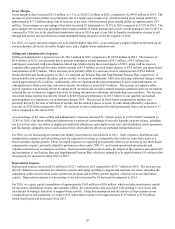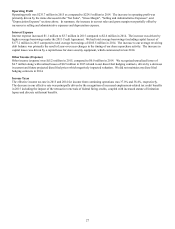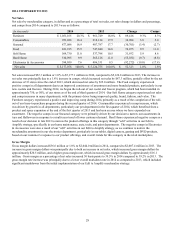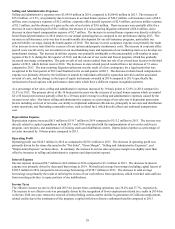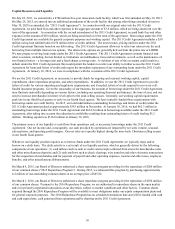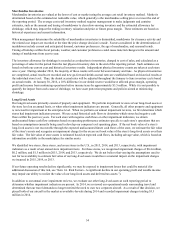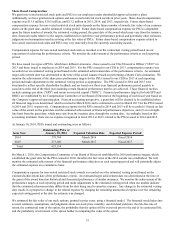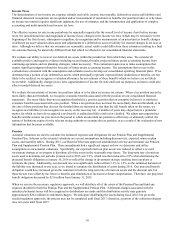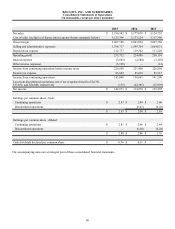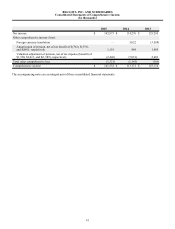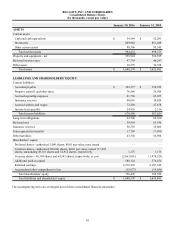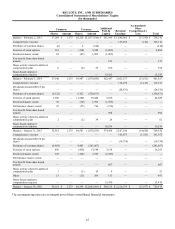Big Lots 2015 Annual Report Download - page 112
Download and view the complete annual report
Please find page 112 of the 2015 Big Lots annual report below. You can navigate through the pages in the report by either clicking on the pages listed below, or by using the keyword search tool below to find specific information within the annual report.
35
Share-Based Compensation
We grant non-vested restricted stock units and PSUs to our employees under shareholder approved incentive plans.
Additionally, we have granted stock options and non-vested restricted stock awards in prior years. Share-based compensation
expense was $13.5 million, $10.5 million, and $13.2 million in 2015, 2014, and 2013, respectively. Future share-based
compensation expense for non-vested restricted stock units depends on the future number of awards, fair value of our common
shares on the grant date, and the estimated vesting period. Future share-based compensation expense for PSUs is dependent
upon the future number of awards, the estimated vesting period, the grant date of the award which may vary from the issuance
date, financial results relative to the targets established for each three-year performance period, and potentially other estimates,
judgments and assumptions used in arriving at the fair value of PSUs. Future share-based compensation expense related to
non-vested restricted stock units and PSUs may vary materially from the currently amortizing awards.
Compensation expense for non-vested restricted stock units is recorded over the contractual vesting period based on our
expectation of achieving the performance criteria. We monitor the achievement of the performance criteria at each reporting
period.
We have issued two types of PSUs, which have different structures - those issued to our Chief Executive Officer (“CEO”) in
2013 and those issued to employees in 2014 and 2015. For the PSUs issued to our CEO in 2013, compensation expense was
recorded over an estimated vesting period based on the estimated achievement date of the performance criteria. An estimated
target achievement date was determined at the time of the award issuance based on performing a Monte Carlo simulation. We
monitor the achievement of the share price performance targets for the PSUs issued to our CEO in 2013 at each reporting
period and make adjustments to the estimated vesting period, as appropriate. The PSUs issued in 2014 and 2015 were
structured to reflect specific shareholder feedback and are based on a three-year financial performance period payable to
associates at the end of the third year assuming certain financial performance metrics are achieved. Those financial metrics
include earnings per share (“EPS”) and return on invested capital (“ROIC”). Financial performance targets (for both EPS and
ROIC) are established by the Compensation Committee of our Board of Directors at the beginning of each fiscal year based on
the Company’s approved operating plan. From an accounting perspective, a grant date will be deemed to be established when
all financial targets are determined, which occurred in March 2016 and is estimated to occur in March 2017 for the PSUs issued
in 2014 and 2015, respectively. Compensation expense for the PSUs issued in 2014 and 2015 will be recorded (1) based on fair
value of the award on the grant date and the estimated achievement of financial performance objectives, and (2) on a straight-
line basis from the grant date, which may vary from the issuance date, through the vesting date. Accordingly, based on this
accounting treatment, there was no expense recognized in fiscal 2014 or 2015, related to the PSUs issued in 2014 and 2015.
At January 30, 2016, PSUs issued and outstanding were as follows:
Issue Year
Outstanding PSUs at
January 30, 2016 Expected Valuation Date Expected Expense Period
2014 379,794 March 2016 Fiscal 2016
2015 273,340 March 2017 Fiscal 2017
Total 653,134
On March 1, 2016, the Compensation Committee of our Board of Directors established the 2016 performance targets, which
established the grant date for the PSUs issued in 2014; therefore the fair value of the 2014 awards was established. We will
monitor the estimated achievement of the financial performance objectives at each reporting period and will potentially adjust
the estimated expense on a cumulative basis.
Compensation expense for non-vested restricted stock awards is recorded over the estimated vesting period based on the
estimated achievement date of the performance criteria. An estimated target achievement date was determined at the time of
the grant of the award based on historical and forecasted performance of similar measures. We monitor the achievement of the
performance targets at each reporting period and make adjustments to the estimated vesting period when our models indicate
that the estimated achievement date differs from the date being used to amortize expense. Any change in the estimated vesting
date results in a prospective change to the related expense by charging the remaining unamortized expense over the remaining
expected vesting period at the date the estimate was changed.
We estimated the fair value of our stock options, granted in prior years, using a binomial model. The binomial model takes into
account estimates, assumptions, and judgments about our stock price volatility, our dividend yield rate, the risk-free rate of
return, the contractual term of the option, the probability that the option will be exercised prior to the end of its contractual life,
and the probability of retirement of the option holder in computing the value of the option.



